Property Law: Legal Issues and Solutions
VerifiedAdded on 2023/06/09
|8
|2889
|168
AI Summary
This article discusses various legal issues related to property law, including ownership, delivery of goods, copyright infringement, and protection of confidential information. It also provides solutions to these issues and recommendations for minimizing security breaches by employees.
Contribute Materials
Your contribution can guide someone’s learning journey. Share your
documents today.
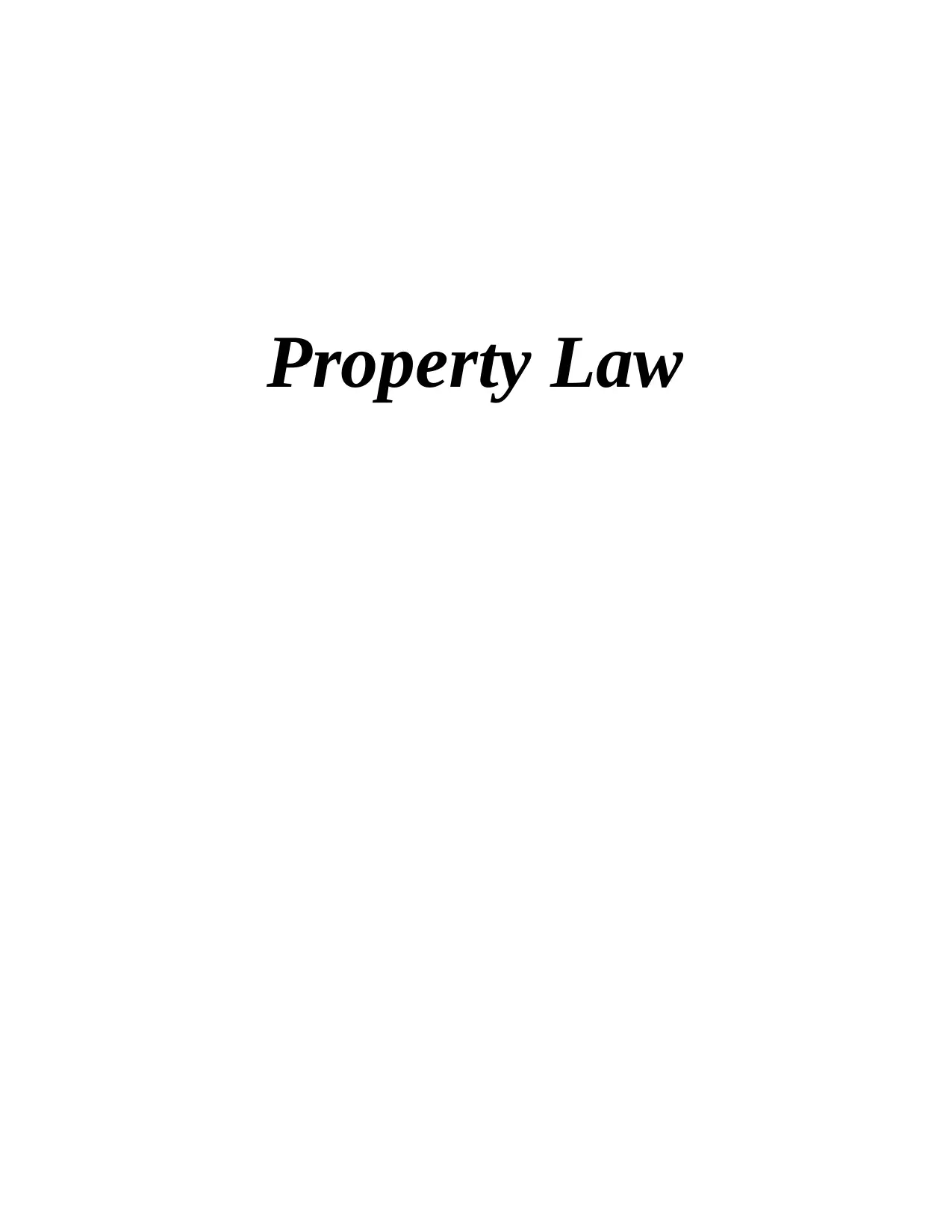
Property Law
Secure Best Marks with AI Grader
Need help grading? Try our AI Grader for instant feedback on your assignments.
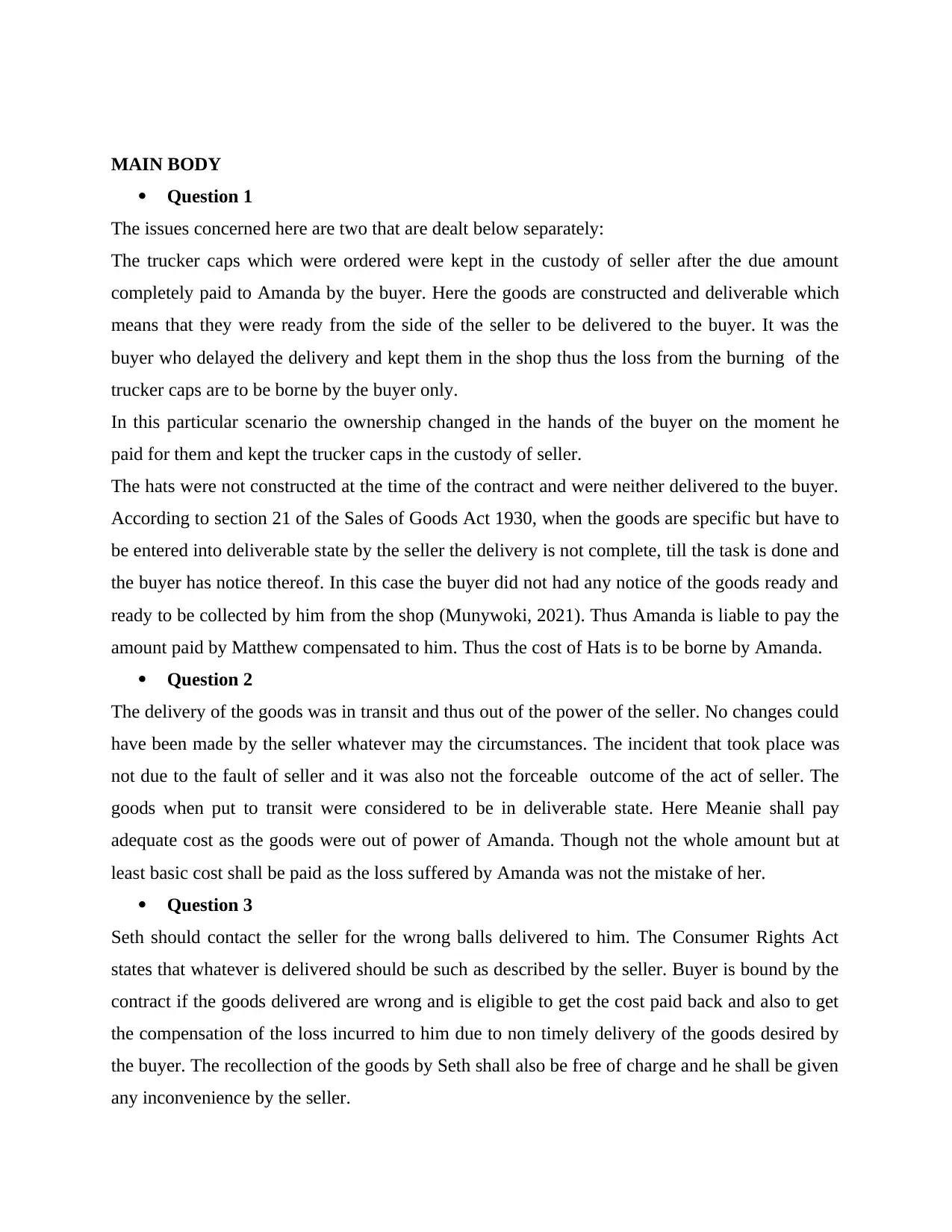
MAIN BODY
Question 1
The issues concerned here are two that are dealt below separately:
The trucker caps which were ordered were kept in the custody of seller after the due amount
completely paid to Amanda by the buyer. Here the goods are constructed and deliverable which
means that they were ready from the side of the seller to be delivered to the buyer. It was the
buyer who delayed the delivery and kept them in the shop thus the loss from the burning of the
trucker caps are to be borne by the buyer only.
In this particular scenario the ownership changed in the hands of the buyer on the moment he
paid for them and kept the trucker caps in the custody of seller.
The hats were not constructed at the time of the contract and were neither delivered to the buyer.
According to section 21 of the Sales of Goods Act 1930, when the goods are specific but have to
be entered into deliverable state by the seller the delivery is not complete, till the task is done and
the buyer has notice thereof. In this case the buyer did not had any notice of the goods ready and
ready to be collected by him from the shop (Munywoki, 2021). Thus Amanda is liable to pay the
amount paid by Matthew compensated to him. Thus the cost of Hats is to be borne by Amanda.
Question 2
The delivery of the goods was in transit and thus out of the power of the seller. No changes could
have been made by the seller whatever may the circumstances. The incident that took place was
not due to the fault of seller and it was also not the forceable outcome of the act of seller. The
goods when put to transit were considered to be in deliverable state. Here Meanie shall pay
adequate cost as the goods were out of power of Amanda. Though not the whole amount but at
least basic cost shall be paid as the loss suffered by Amanda was not the mistake of her.
Question 3
Seth should contact the seller for the wrong balls delivered to him. The Consumer Rights Act
states that whatever is delivered should be such as described by the seller. Buyer is bound by the
contract if the goods delivered are wrong and is eligible to get the cost paid back and also to get
the compensation of the loss incurred to him due to non timely delivery of the goods desired by
the buyer. The recollection of the goods by Seth shall also be free of charge and he shall be given
any inconvenience by the seller.
Question 1
The issues concerned here are two that are dealt below separately:
The trucker caps which were ordered were kept in the custody of seller after the due amount
completely paid to Amanda by the buyer. Here the goods are constructed and deliverable which
means that they were ready from the side of the seller to be delivered to the buyer. It was the
buyer who delayed the delivery and kept them in the shop thus the loss from the burning of the
trucker caps are to be borne by the buyer only.
In this particular scenario the ownership changed in the hands of the buyer on the moment he
paid for them and kept the trucker caps in the custody of seller.
The hats were not constructed at the time of the contract and were neither delivered to the buyer.
According to section 21 of the Sales of Goods Act 1930, when the goods are specific but have to
be entered into deliverable state by the seller the delivery is not complete, till the task is done and
the buyer has notice thereof. In this case the buyer did not had any notice of the goods ready and
ready to be collected by him from the shop (Munywoki, 2021). Thus Amanda is liable to pay the
amount paid by Matthew compensated to him. Thus the cost of Hats is to be borne by Amanda.
Question 2
The delivery of the goods was in transit and thus out of the power of the seller. No changes could
have been made by the seller whatever may the circumstances. The incident that took place was
not due to the fault of seller and it was also not the forceable outcome of the act of seller. The
goods when put to transit were considered to be in deliverable state. Here Meanie shall pay
adequate cost as the goods were out of power of Amanda. Though not the whole amount but at
least basic cost shall be paid as the loss suffered by Amanda was not the mistake of her.
Question 3
Seth should contact the seller for the wrong balls delivered to him. The Consumer Rights Act
states that whatever is delivered should be such as described by the seller. Buyer is bound by the
contract if the goods delivered are wrong and is eligible to get the cost paid back and also to get
the compensation of the loss incurred to him due to non timely delivery of the goods desired by
the buyer. The recollection of the goods by Seth shall also be free of charge and he shall be given
any inconvenience by the seller.
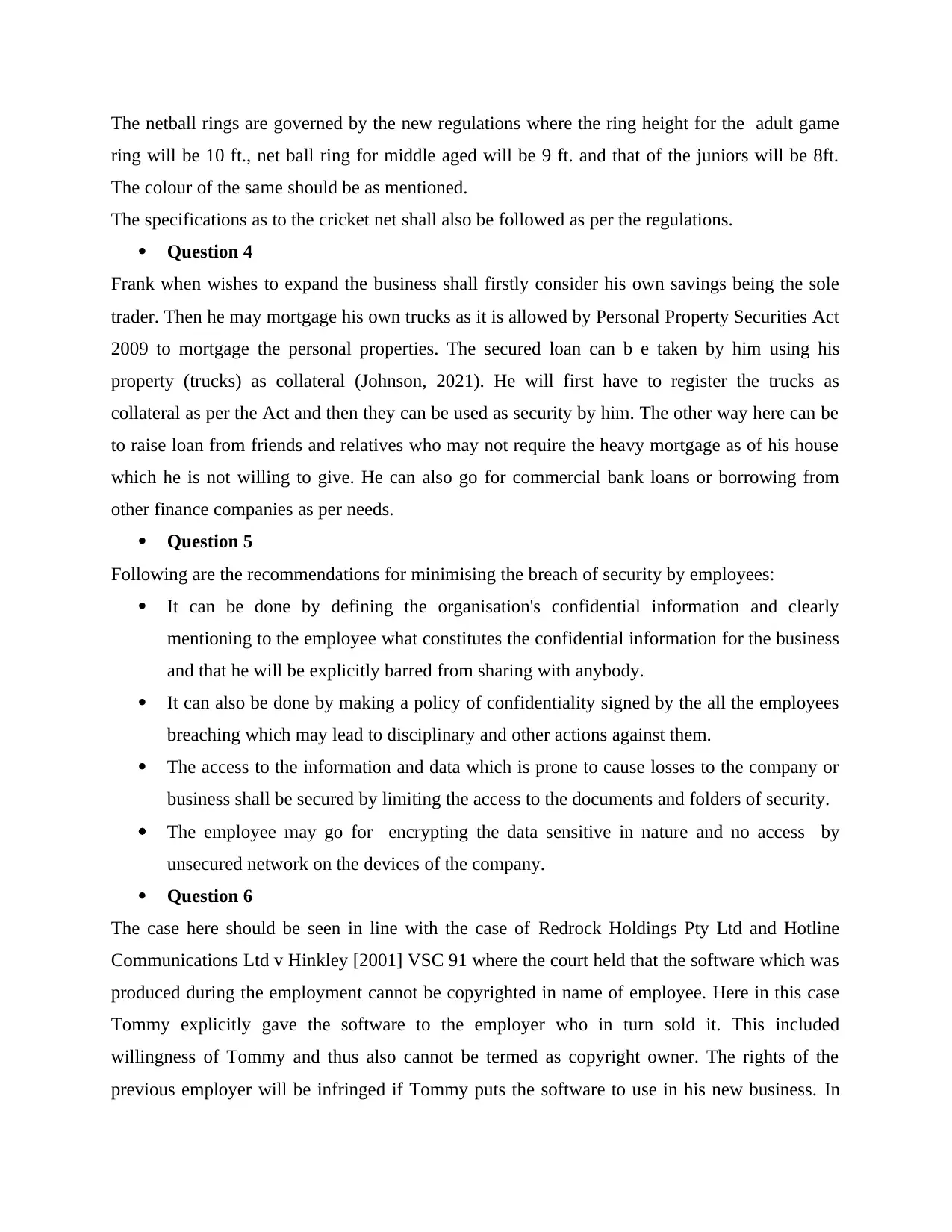
The netball rings are governed by the new regulations where the ring height for the adult game
ring will be 10 ft., net ball ring for middle aged will be 9 ft. and that of the juniors will be 8ft.
The colour of the same should be as mentioned.
The specifications as to the cricket net shall also be followed as per the regulations.
Question 4
Frank when wishes to expand the business shall firstly consider his own savings being the sole
trader. Then he may mortgage his own trucks as it is allowed by Personal Property Securities Act
2009 to mortgage the personal properties. The secured loan can b e taken by him using his
property (trucks) as collateral (Johnson, 2021). He will first have to register the trucks as
collateral as per the Act and then they can be used as security by him. The other way here can be
to raise loan from friends and relatives who may not require the heavy mortgage as of his house
which he is not willing to give. He can also go for commercial bank loans or borrowing from
other finance companies as per needs.
Question 5
Following are the recommendations for minimising the breach of security by employees:
It can be done by defining the organisation's confidential information and clearly
mentioning to the employee what constitutes the confidential information for the business
and that he will be explicitly barred from sharing with anybody.
It can also be done by making a policy of confidentiality signed by the all the employees
breaching which may lead to disciplinary and other actions against them.
The access to the information and data which is prone to cause losses to the company or
business shall be secured by limiting the access to the documents and folders of security.
The employee may go for encrypting the data sensitive in nature and no access by
unsecured network on the devices of the company.
Question 6
The case here should be seen in line with the case of Redrock Holdings Pty Ltd and Hotline
Communications Ltd v Hinkley [2001] VSC 91 where the court held that the software which was
produced during the employment cannot be copyrighted in name of employee. Here in this case
Tommy explicitly gave the software to the employer who in turn sold it. This included
willingness of Tommy and thus also cannot be termed as copyright owner. The rights of the
previous employer will be infringed if Tommy puts the software to use in his new business. In
ring will be 10 ft., net ball ring for middle aged will be 9 ft. and that of the juniors will be 8ft.
The colour of the same should be as mentioned.
The specifications as to the cricket net shall also be followed as per the regulations.
Question 4
Frank when wishes to expand the business shall firstly consider his own savings being the sole
trader. Then he may mortgage his own trucks as it is allowed by Personal Property Securities Act
2009 to mortgage the personal properties. The secured loan can b e taken by him using his
property (trucks) as collateral (Johnson, 2021). He will first have to register the trucks as
collateral as per the Act and then they can be used as security by him. The other way here can be
to raise loan from friends and relatives who may not require the heavy mortgage as of his house
which he is not willing to give. He can also go for commercial bank loans or borrowing from
other finance companies as per needs.
Question 5
Following are the recommendations for minimising the breach of security by employees:
It can be done by defining the organisation's confidential information and clearly
mentioning to the employee what constitutes the confidential information for the business
and that he will be explicitly barred from sharing with anybody.
It can also be done by making a policy of confidentiality signed by the all the employees
breaching which may lead to disciplinary and other actions against them.
The access to the information and data which is prone to cause losses to the company or
business shall be secured by limiting the access to the documents and folders of security.
The employee may go for encrypting the data sensitive in nature and no access by
unsecured network on the devices of the company.
Question 6
The case here should be seen in line with the case of Redrock Holdings Pty Ltd and Hotline
Communications Ltd v Hinkley [2001] VSC 91 where the court held that the software which was
produced during the employment cannot be copyrighted in name of employee. Here in this case
Tommy explicitly gave the software to the employer who in turn sold it. This included
willingness of Tommy and thus also cannot be termed as copyright owner. The rights of the
previous employer will be infringed if Tommy puts the software to use in his new business. In
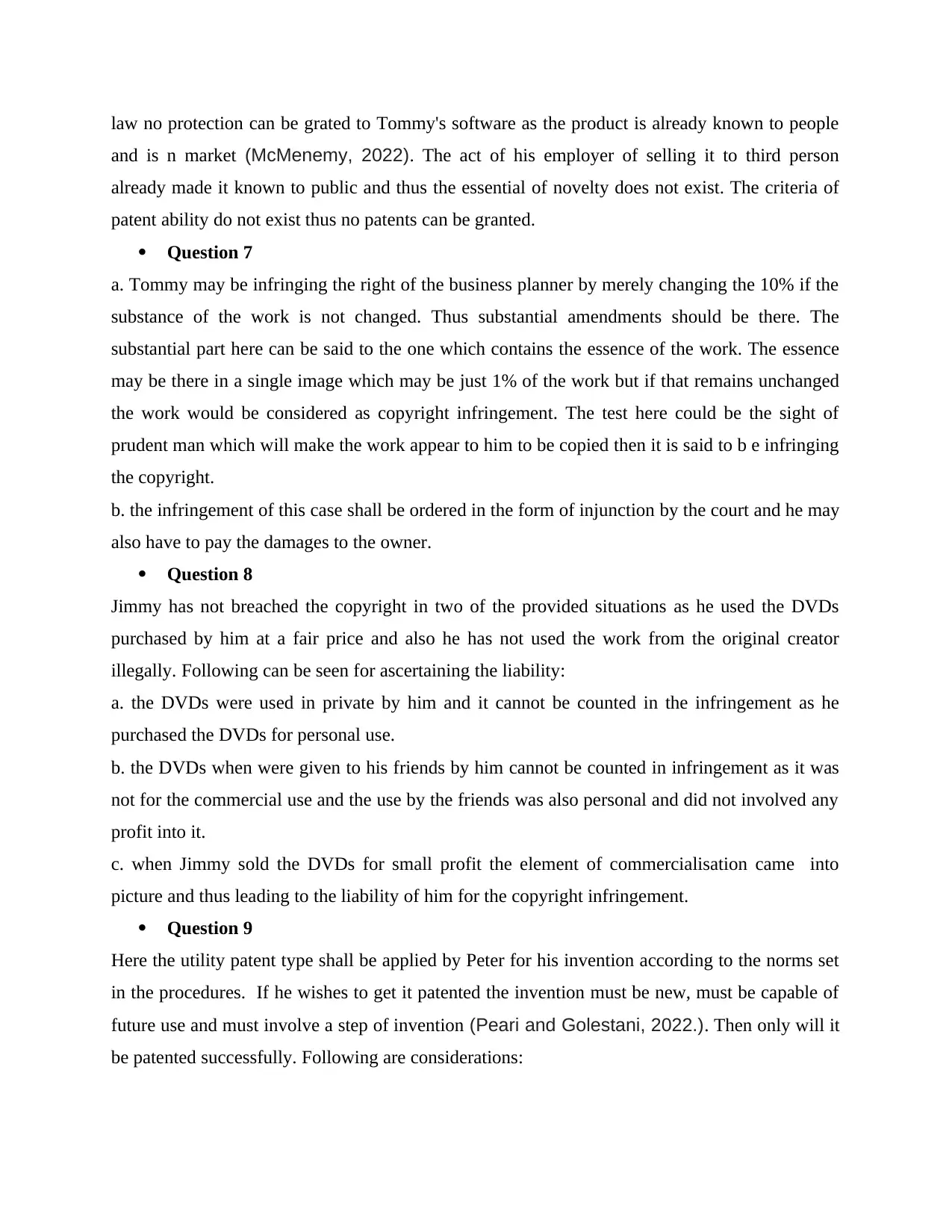
law no protection can be grated to Tommy's software as the product is already known to people
and is n market (McMenemy, 2022). The act of his employer of selling it to third person
already made it known to public and thus the essential of novelty does not exist. The criteria of
patent ability do not exist thus no patents can be granted.
Question 7
a. Tommy may be infringing the right of the business planner by merely changing the 10% if the
substance of the work is not changed. Thus substantial amendments should be there. The
substantial part here can be said to the one which contains the essence of the work. The essence
may be there in a single image which may be just 1% of the work but if that remains unchanged
the work would be considered as copyright infringement. The test here could be the sight of
prudent man which will make the work appear to him to be copied then it is said to b e infringing
the copyright.
b. the infringement of this case shall be ordered in the form of injunction by the court and he may
also have to pay the damages to the owner.
Question 8
Jimmy has not breached the copyright in two of the provided situations as he used the DVDs
purchased by him at a fair price and also he has not used the work from the original creator
illegally. Following can be seen for ascertaining the liability:
a. the DVDs were used in private by him and it cannot be counted in the infringement as he
purchased the DVDs for personal use.
b. the DVDs when were given to his friends by him cannot be counted in infringement as it was
not for the commercial use and the use by the friends was also personal and did not involved any
profit into it.
c. when Jimmy sold the DVDs for small profit the element of commercialisation came into
picture and thus leading to the liability of him for the copyright infringement.
Question 9
Here the utility patent type shall be applied by Peter for his invention according to the norms set
in the procedures. If he wishes to get it patented the invention must be new, must be capable of
future use and must involve a step of invention (Peari and Golestani, 2022.). Then only will it
be patented successfully. Following are considerations:
and is n market (McMenemy, 2022). The act of his employer of selling it to third person
already made it known to public and thus the essential of novelty does not exist. The criteria of
patent ability do not exist thus no patents can be granted.
Question 7
a. Tommy may be infringing the right of the business planner by merely changing the 10% if the
substance of the work is not changed. Thus substantial amendments should be there. The
substantial part here can be said to the one which contains the essence of the work. The essence
may be there in a single image which may be just 1% of the work but if that remains unchanged
the work would be considered as copyright infringement. The test here could be the sight of
prudent man which will make the work appear to him to be copied then it is said to b e infringing
the copyright.
b. the infringement of this case shall be ordered in the form of injunction by the court and he may
also have to pay the damages to the owner.
Question 8
Jimmy has not breached the copyright in two of the provided situations as he used the DVDs
purchased by him at a fair price and also he has not used the work from the original creator
illegally. Following can be seen for ascertaining the liability:
a. the DVDs were used in private by him and it cannot be counted in the infringement as he
purchased the DVDs for personal use.
b. the DVDs when were given to his friends by him cannot be counted in infringement as it was
not for the commercial use and the use by the friends was also personal and did not involved any
profit into it.
c. when Jimmy sold the DVDs for small profit the element of commercialisation came into
picture and thus leading to the liability of him for the copyright infringement.
Question 9
Here the utility patent type shall be applied by Peter for his invention according to the norms set
in the procedures. If he wishes to get it patented the invention must be new, must be capable of
future use and must involve a step of invention (Peari and Golestani, 2022.). Then only will it
be patented successfully. Following are considerations:
Secure Best Marks with AI Grader
Need help grading? Try our AI Grader for instant feedback on your assignments.
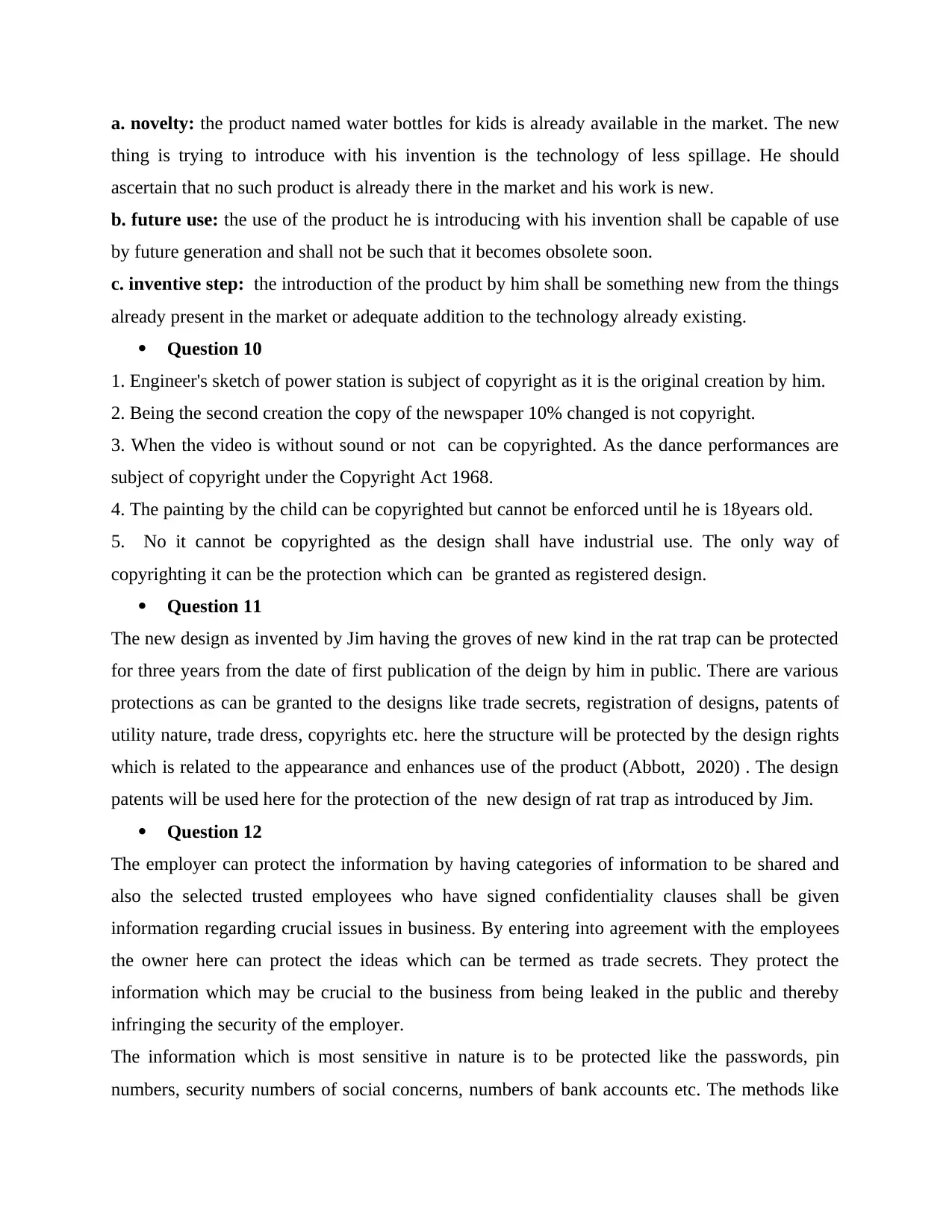
a. novelty: the product named water bottles for kids is already available in the market. The new
thing is trying to introduce with his invention is the technology of less spillage. He should
ascertain that no such product is already there in the market and his work is new.
b. future use: the use of the product he is introducing with his invention shall be capable of use
by future generation and shall not be such that it becomes obsolete soon.
c. inventive step: the introduction of the product by him shall be something new from the things
already present in the market or adequate addition to the technology already existing.
Question 10
1. Engineer's sketch of power station is subject of copyright as it is the original creation by him.
2. Being the second creation the copy of the newspaper 10% changed is not copyright.
3. When the video is without sound or not can be copyrighted. As the dance performances are
subject of copyright under the Copyright Act 1968.
4. The painting by the child can be copyrighted but cannot be enforced until he is 18years old.
5. No it cannot be copyrighted as the design shall have industrial use. The only way of
copyrighting it can be the protection which can be granted as registered design.
Question 11
The new design as invented by Jim having the groves of new kind in the rat trap can be protected
for three years from the date of first publication of the deign by him in public. There are various
protections as can be granted to the designs like trade secrets, registration of designs, patents of
utility nature, trade dress, copyrights etc. here the structure will be protected by the design rights
which is related to the appearance and enhances use of the product (Abbott, 2020) . The design
patents will be used here for the protection of the new design of rat trap as introduced by Jim.
Question 12
The employer can protect the information by having categories of information to be shared and
also the selected trusted employees who have signed confidentiality clauses shall be given
information regarding crucial issues in business. By entering into agreement with the employees
the owner here can protect the ideas which can be termed as trade secrets. They protect the
information which may be crucial to the business from being leaked in the public and thereby
infringing the security of the employer.
The information which is most sensitive in nature is to be protected like the passwords, pin
numbers, security numbers of social concerns, numbers of bank accounts etc. The methods like
thing is trying to introduce with his invention is the technology of less spillage. He should
ascertain that no such product is already there in the market and his work is new.
b. future use: the use of the product he is introducing with his invention shall be capable of use
by future generation and shall not be such that it becomes obsolete soon.
c. inventive step: the introduction of the product by him shall be something new from the things
already present in the market or adequate addition to the technology already existing.
Question 10
1. Engineer's sketch of power station is subject of copyright as it is the original creation by him.
2. Being the second creation the copy of the newspaper 10% changed is not copyright.
3. When the video is without sound or not can be copyrighted. As the dance performances are
subject of copyright under the Copyright Act 1968.
4. The painting by the child can be copyrighted but cannot be enforced until he is 18years old.
5. No it cannot be copyrighted as the design shall have industrial use. The only way of
copyrighting it can be the protection which can be granted as registered design.
Question 11
The new design as invented by Jim having the groves of new kind in the rat trap can be protected
for three years from the date of first publication of the deign by him in public. There are various
protections as can be granted to the designs like trade secrets, registration of designs, patents of
utility nature, trade dress, copyrights etc. here the structure will be protected by the design rights
which is related to the appearance and enhances use of the product (Abbott, 2020) . The design
patents will be used here for the protection of the new design of rat trap as introduced by Jim.
Question 12
The employer can protect the information by having categories of information to be shared and
also the selected trusted employees who have signed confidentiality clauses shall be given
information regarding crucial issues in business. By entering into agreement with the employees
the owner here can protect the ideas which can be termed as trade secrets. They protect the
information which may be crucial to the business from being leaked in the public and thereby
infringing the security of the employer.
The information which is most sensitive in nature is to be protected like the passwords, pin
numbers, security numbers of social concerns, numbers of bank accounts etc. The methods like
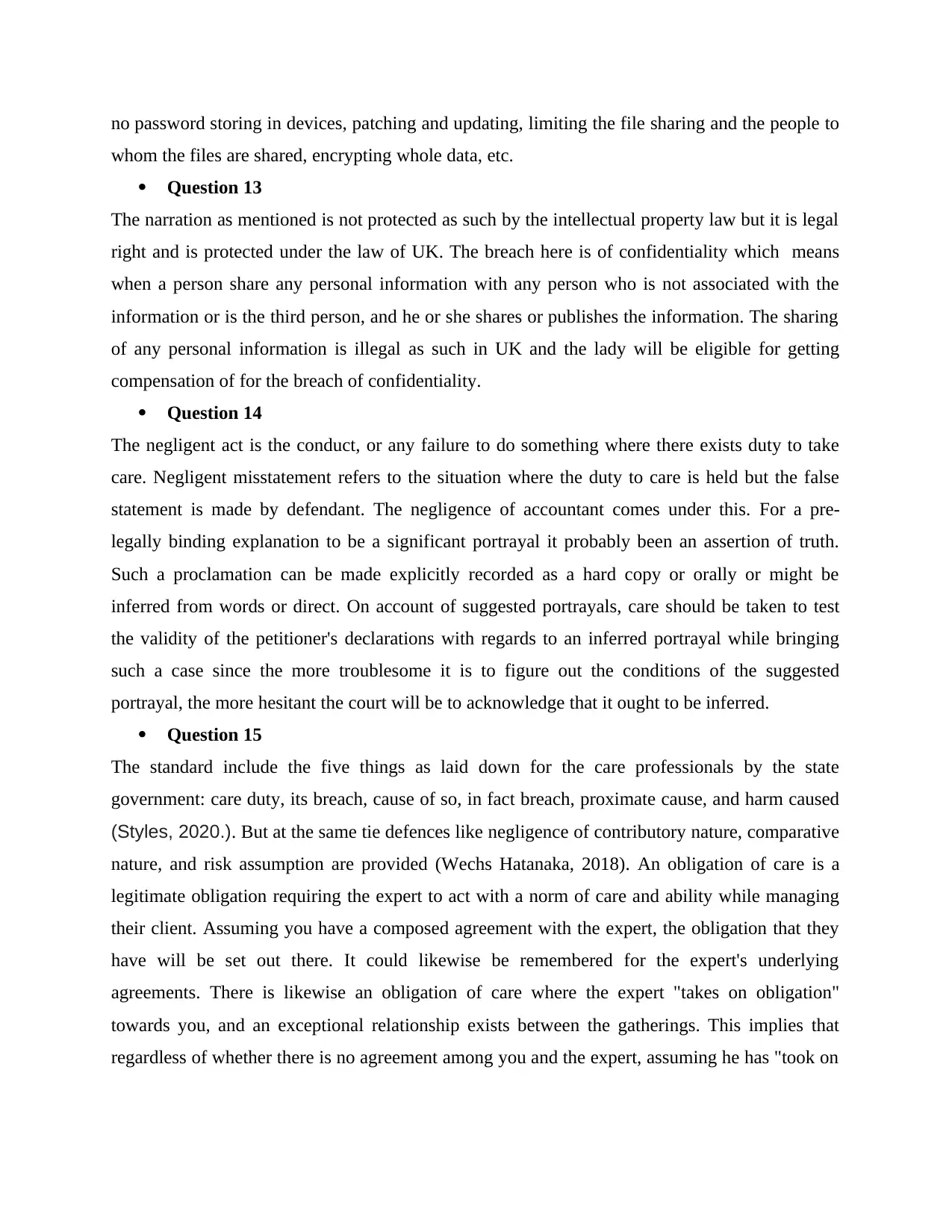
no password storing in devices, patching and updating, limiting the file sharing and the people to
whom the files are shared, encrypting whole data, etc.
Question 13
The narration as mentioned is not protected as such by the intellectual property law but it is legal
right and is protected under the law of UK. The breach here is of confidentiality which means
when a person share any personal information with any person who is not associated with the
information or is the third person, and he or she shares or publishes the information. The sharing
of any personal information is illegal as such in UK and the lady will be eligible for getting
compensation of for the breach of confidentiality.
Question 14
The negligent act is the conduct, or any failure to do something where there exists duty to take
care. Negligent misstatement refers to the situation where the duty to care is held but the false
statement is made by defendant. The negligence of accountant comes under this. For a pre-
legally binding explanation to be a significant portrayal it probably been an assertion of truth.
Such a proclamation can be made explicitly recorded as a hard copy or orally or might be
inferred from words or direct. On account of suggested portrayals, care should be taken to test
the validity of the petitioner's declarations with regards to an inferred portrayal while bringing
such a case since the more troublesome it is to figure out the conditions of the suggested
portrayal, the more hesitant the court will be to acknowledge that it ought to be inferred.
Question 15
The standard include the five things as laid down for the care professionals by the state
government: care duty, its breach, cause of so, in fact breach, proximate cause, and harm caused
(Styles, 2020.). But at the same tie defences like negligence of contributory nature, comparative
nature, and risk assumption are provided (Wechs Hatanaka, 2018). An obligation of care is a
legitimate obligation requiring the expert to act with a norm of care and ability while managing
their client. Assuming you have a composed agreement with the expert, the obligation that they
have will be set out there. It could likewise be remembered for the expert's underlying
agreements. There is likewise an obligation of care where the expert "takes on obligation"
towards you, and an exceptional relationship exists between the gatherings. This implies that
regardless of whether there is no agreement among you and the expert, assuming he has "took on
whom the files are shared, encrypting whole data, etc.
Question 13
The narration as mentioned is not protected as such by the intellectual property law but it is legal
right and is protected under the law of UK. The breach here is of confidentiality which means
when a person share any personal information with any person who is not associated with the
information or is the third person, and he or she shares or publishes the information. The sharing
of any personal information is illegal as such in UK and the lady will be eligible for getting
compensation of for the breach of confidentiality.
Question 14
The negligent act is the conduct, or any failure to do something where there exists duty to take
care. Negligent misstatement refers to the situation where the duty to care is held but the false
statement is made by defendant. The negligence of accountant comes under this. For a pre-
legally binding explanation to be a significant portrayal it probably been an assertion of truth.
Such a proclamation can be made explicitly recorded as a hard copy or orally or might be
inferred from words or direct. On account of suggested portrayals, care should be taken to test
the validity of the petitioner's declarations with regards to an inferred portrayal while bringing
such a case since the more troublesome it is to figure out the conditions of the suggested
portrayal, the more hesitant the court will be to acknowledge that it ought to be inferred.
Question 15
The standard include the five things as laid down for the care professionals by the state
government: care duty, its breach, cause of so, in fact breach, proximate cause, and harm caused
(Styles, 2020.). But at the same tie defences like negligence of contributory nature, comparative
nature, and risk assumption are provided (Wechs Hatanaka, 2018). An obligation of care is a
legitimate obligation requiring the expert to act with a norm of care and ability while managing
their client. Assuming you have a composed agreement with the expert, the obligation that they
have will be set out there. It could likewise be remembered for the expert's underlying
agreements. There is likewise an obligation of care where the expert "takes on obligation"
towards you, and an exceptional relationship exists between the gatherings. This implies that
regardless of whether there is no agreement among you and the expert, assuming he has "took on
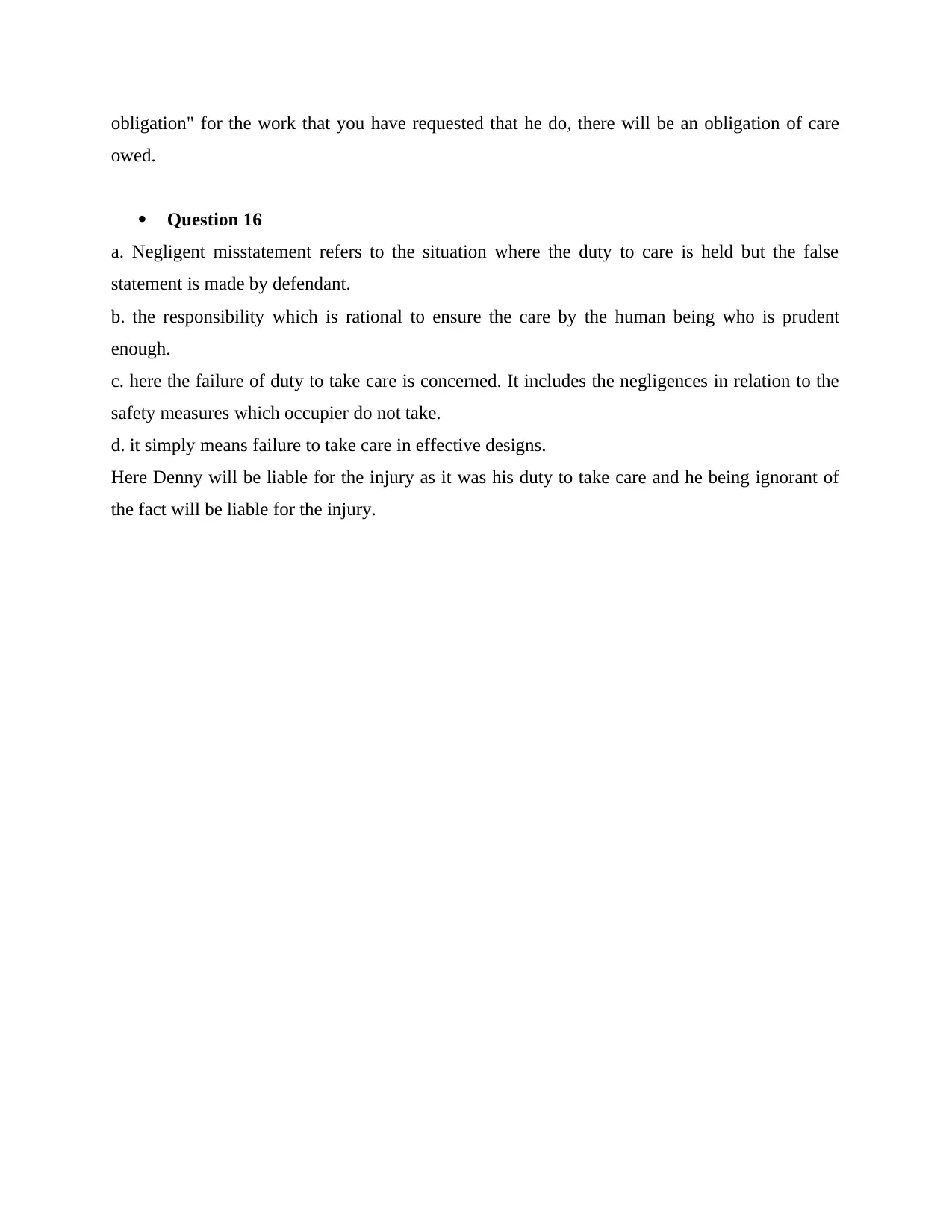
obligation" for the work that you have requested that he do, there will be an obligation of care
owed.
Question 16
a. Negligent misstatement refers to the situation where the duty to care is held but the false
statement is made by defendant.
b. the responsibility which is rational to ensure the care by the human being who is prudent
enough.
c. here the failure of duty to take care is concerned. It includes the negligences in relation to the
safety measures which occupier do not take.
d. it simply means failure to take care in effective designs.
Here Denny will be liable for the injury as it was his duty to take care and he being ignorant of
the fact will be liable for the injury.
owed.
Question 16
a. Negligent misstatement refers to the situation where the duty to care is held but the false
statement is made by defendant.
b. the responsibility which is rational to ensure the care by the human being who is prudent
enough.
c. here the failure of duty to take care is concerned. It includes the negligences in relation to the
safety measures which occupier do not take.
d. it simply means failure to take care in effective designs.
Here Denny will be liable for the injury as it was his duty to take care and he being ignorant of
the fact will be liable for the injury.
Paraphrase This Document
Need a fresh take? Get an instant paraphrase of this document with our AI Paraphraser
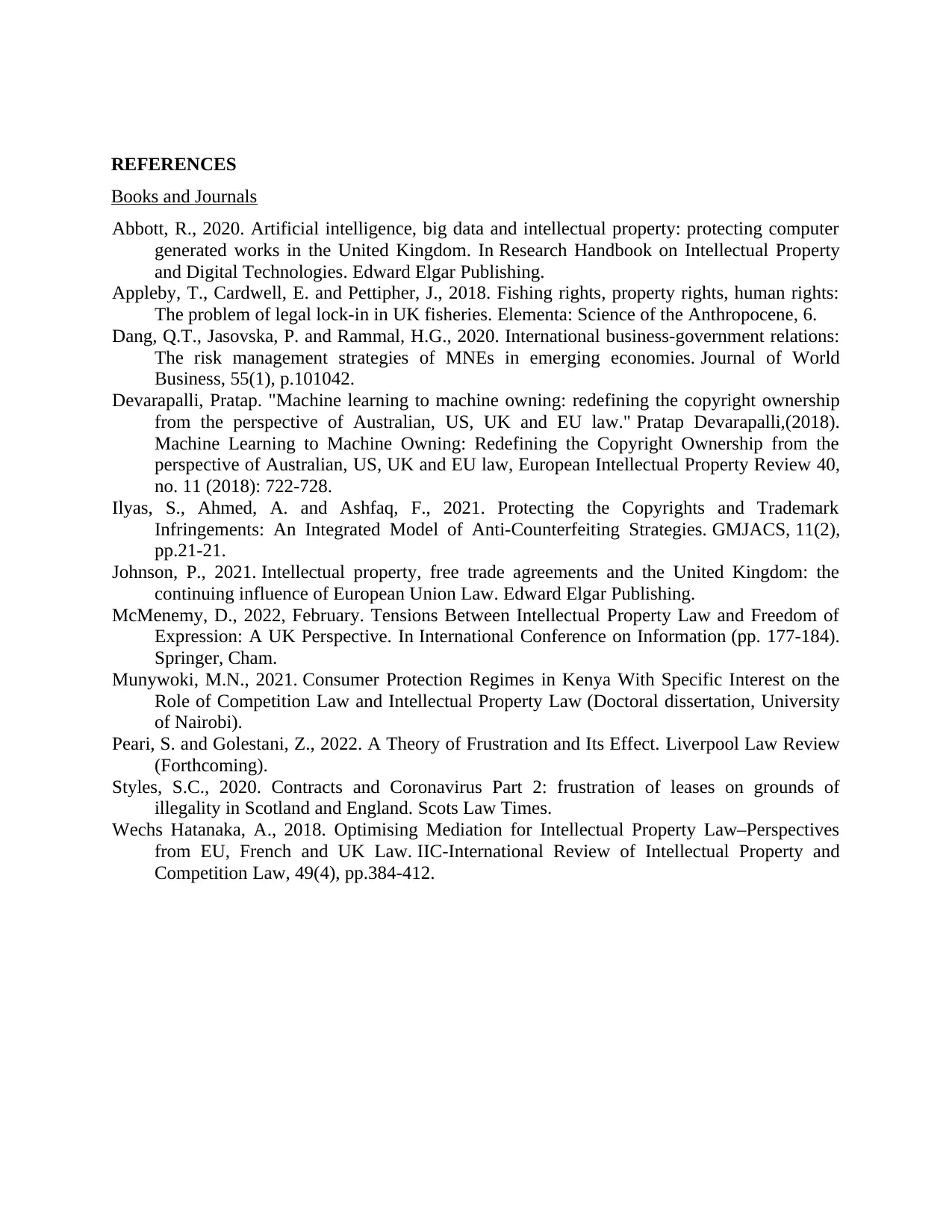
REFERENCES
Books and Journals
Abbott, R., 2020. Artificial intelligence, big data and intellectual property: protecting computer
generated works in the United Kingdom. In Research Handbook on Intellectual Property
and Digital Technologies. Edward Elgar Publishing.
Appleby, T., Cardwell, E. and Pettipher, J., 2018. Fishing rights, property rights, human rights:
The problem of legal lock-in in UK fisheries. Elementa: Science of the Anthropocene, 6.
Dang, Q.T., Jasovska, P. and Rammal, H.G., 2020. International business-government relations:
The risk management strategies of MNEs in emerging economies. Journal of World
Business, 55(1), p.101042.
Devarapalli, Pratap. "Machine learning to machine owning: redefining the copyright ownership
from the perspective of Australian, US, UK and EU law." Pratap Devarapalli,(2018).
Machine Learning to Machine Owning: Redefining the Copyright Ownership from the
perspective of Australian, US, UK and EU law, European Intellectual Property Review 40,
no. 11 (2018): 722-728.
Ilyas, S., Ahmed, A. and Ashfaq, F., 2021. Protecting the Copyrights and Trademark
Infringements: An Integrated Model of Anti-Counterfeiting Strategies. GMJACS, 11(2),
pp.21-21.
Johnson, P., 2021. Intellectual property, free trade agreements and the United Kingdom: the
continuing influence of European Union Law. Edward Elgar Publishing.
McMenemy, D., 2022, February. Tensions Between Intellectual Property Law and Freedom of
Expression: A UK Perspective. In International Conference on Information (pp. 177-184).
Springer, Cham.
Munywoki, M.N., 2021. Consumer Protection Regimes in Kenya With Specific Interest on the
Role of Competition Law and Intellectual Property Law (Doctoral dissertation, University
of Nairobi).
Peari, S. and Golestani, Z., 2022. A Theory of Frustration and Its Effect. Liverpool Law Review
(Forthcoming).
Styles, S.C., 2020. Contracts and Coronavirus Part 2: frustration of leases on grounds of
illegality in Scotland and England. Scots Law Times.
Wechs Hatanaka, A., 2018. Optimising Mediation for Intellectual Property Law–Perspectives
from EU, French and UK Law. IIC-International Review of Intellectual Property and
Competition Law, 49(4), pp.384-412.
Books and Journals
Abbott, R., 2020. Artificial intelligence, big data and intellectual property: protecting computer
generated works in the United Kingdom. In Research Handbook on Intellectual Property
and Digital Technologies. Edward Elgar Publishing.
Appleby, T., Cardwell, E. and Pettipher, J., 2018. Fishing rights, property rights, human rights:
The problem of legal lock-in in UK fisheries. Elementa: Science of the Anthropocene, 6.
Dang, Q.T., Jasovska, P. and Rammal, H.G., 2020. International business-government relations:
The risk management strategies of MNEs in emerging economies. Journal of World
Business, 55(1), p.101042.
Devarapalli, Pratap. "Machine learning to machine owning: redefining the copyright ownership
from the perspective of Australian, US, UK and EU law." Pratap Devarapalli,(2018).
Machine Learning to Machine Owning: Redefining the Copyright Ownership from the
perspective of Australian, US, UK and EU law, European Intellectual Property Review 40,
no. 11 (2018): 722-728.
Ilyas, S., Ahmed, A. and Ashfaq, F., 2021. Protecting the Copyrights and Trademark
Infringements: An Integrated Model of Anti-Counterfeiting Strategies. GMJACS, 11(2),
pp.21-21.
Johnson, P., 2021. Intellectual property, free trade agreements and the United Kingdom: the
continuing influence of European Union Law. Edward Elgar Publishing.
McMenemy, D., 2022, February. Tensions Between Intellectual Property Law and Freedom of
Expression: A UK Perspective. In International Conference on Information (pp. 177-184).
Springer, Cham.
Munywoki, M.N., 2021. Consumer Protection Regimes in Kenya With Specific Interest on the
Role of Competition Law and Intellectual Property Law (Doctoral dissertation, University
of Nairobi).
Peari, S. and Golestani, Z., 2022. A Theory of Frustration and Its Effect. Liverpool Law Review
(Forthcoming).
Styles, S.C., 2020. Contracts and Coronavirus Part 2: frustration of leases on grounds of
illegality in Scotland and England. Scots Law Times.
Wechs Hatanaka, A., 2018. Optimising Mediation for Intellectual Property Law–Perspectives
from EU, French and UK Law. IIC-International Review of Intellectual Property and
Competition Law, 49(4), pp.384-412.
1 out of 8
Your All-in-One AI-Powered Toolkit for Academic Success.
+13062052269
info@desklib.com
Available 24*7 on WhatsApp / Email
![[object Object]](/_next/static/media/star-bottom.7253800d.svg)
Unlock your academic potential
© 2024 | Zucol Services PVT LTD | All rights reserved.